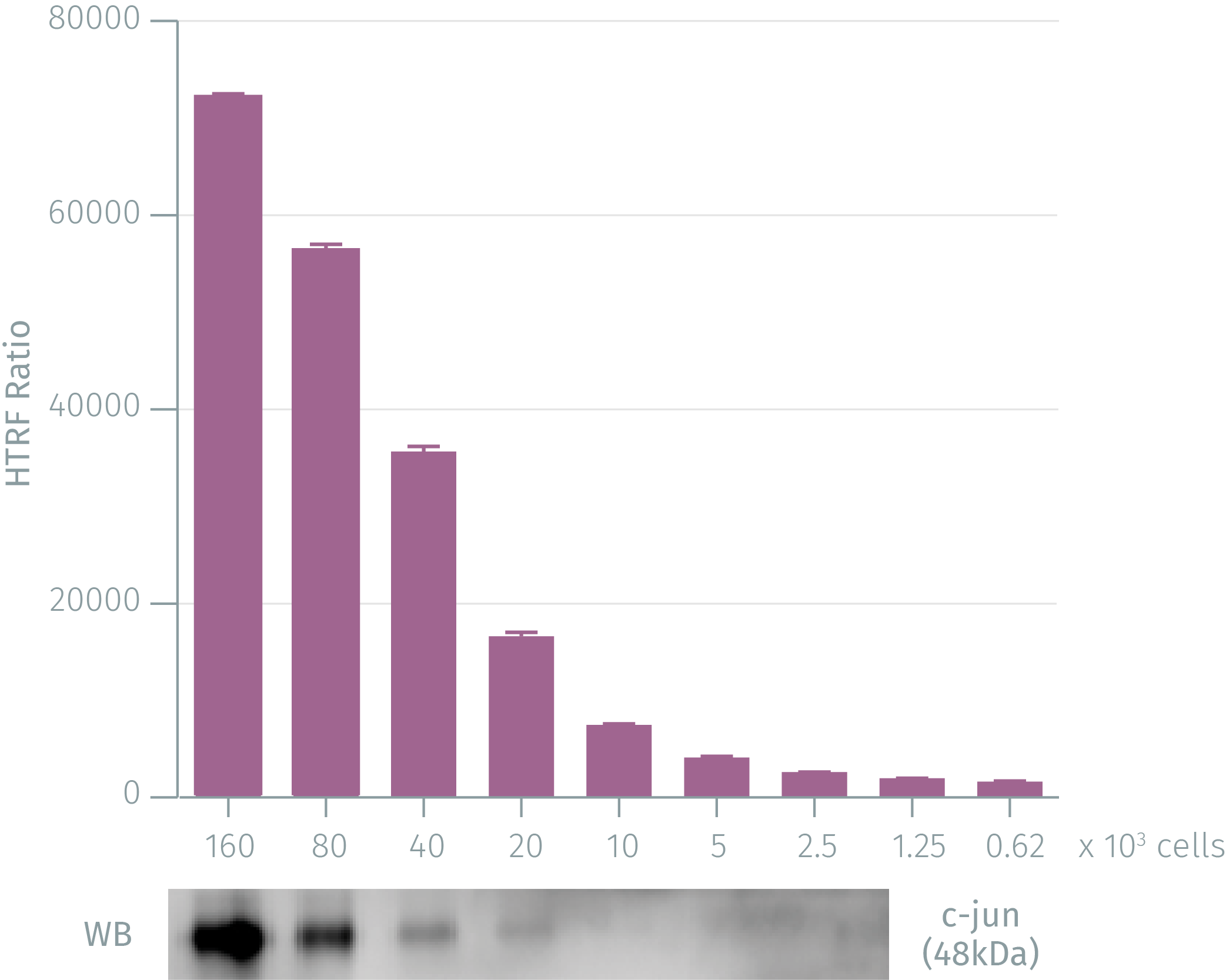

HTRF Human and Mouse Phospho-c-Jun (Ser63) Detection Kit, 500 Assay Points






The Phospho-c-Jun (Ser63) kit enables the cell-based quantitative detection of cJun protein phosphorylated at Ser63.
For research use only. Not for use in diagnostic procedures. All products to be used in accordance with applicable laws and regulations including without limitation, consumption & disposal requirements under European REACH regulations (EC 1907/2006).
Product information
Overview
The Phospho-c-Jun (Ser63) Cellular Assay kit is designed for the robust quantification of phoshorylated c-Jun at Ser-36 directly in cell lysates. Using a streamlined mix-and-read no-wash protocol, this kit can be used from basic research to High Throughput drug screening.
Specifications
| Assay Points |
500
|
|---|---|
| Assay Target Type |
Kit
|
| Assay Technology |
HTRF
|
| Brand |
HTRF
|
| Quantity |
1
|
| Shipping Conditions |
Shipped in Dry Ice
|
| Therapeutic Area |
NASH/Fibrosis
Oncology & Inflammation
|
| Unit Size |
500 Assay Points
|
Video gallery


How it works
Phospho-c-Jun (Ser63) assay principle
The Phospho-c-Jun (Ser63) assay measures c-Jun when phosphorylated at Ser63. Contrary to Western Blot, the assay is entirely plate-based and does not require gels, electrophoresis or transfer. The Phospho-c-Jun (Ser63) assay uses 2 labeled antibodies: one with a donor fluorophore, the other one with an acceptor. The first antibody is selected for its specific binding to the phosphorylated motif on the protein, the second for its ability to recognize the protein independent of its phosphorylation state. Protein phosphorylation enables an immune-complex formation involving both labeled antibodies and which brings the donor fluorophore into close proximity to the acceptor, thereby generating a FRET signal. Its intensity is directly proportional to the concentration of phosphorylated protein present in the sample, and provides a means of assessing the proteins phosphorylation state under a no-wash assay format.

Phospho-c-Jun (Ser63) 2-plate assay protocol
The 2 plate protocol involves culturing cells in a 96-well plate before lysis then transferring lysates to a 384-well low volume detection plate before adding phospho-c-Jun (Ser63) HTRF detection reagents. This protocol enables the cells' viability and confluence to be monitored.

Phospho-c-Jun (Ser63) 1-plate assay protocol
Detection of Phosphorylated c-Jun (Ser63) with HTRF reagents can be performed in a single plate used for culturing, stimulation and lysis. No washing steps are required. This HTS designed protocol enables miniaturization while maintaining robust HTRF quality.

Assay validation
WB versus HTRF assay for Phospho-c-Jun (Ser63) kit
HEK293 cells were cultured for two days and stimulated with 500nM anisomycin for 30 min. After removal of cell culture medium, lysis buffer was added and the cells were incubated for 30 min. Supernatants were collected following centrifugation and equal amounts of lysates were used for a side by side comparison of WB and HTRF. The HTRF assay proved to be 8-fold more sensitive than the western-blot assay.

Anysomycin dose-response on NIH-3T3 cells for Phospho-c-Jun kit
Murine NIH-3T3 cells (50,000 cells/well) were stimulated for 30 minutes at 37°C with various concentrations of anisomycin. After a 30 minutes lysis incubation time, phosphorylated c-Jun was measured using the two-plate assay protocol of the Phospho-c-Jun assay.

Inhibition effect of c-Jun on HEK293 stimulated with anisomycin
HEK293 cells (50,000 cells/well) were incubated for 1h at 37°C with various concentrations of cell-permeable c-Jun peptide. 50nM anisomycin (agonist) were then added and incubated for 30 minutess. After a 30 minutes lysis incubation time, inhibition of c-Jun phosphorylation was measured using the Phospho-c-Jun assay. Assay was done using the two-plate assay protocol.

Simplified pathway
Simplified pathway of c-Jun protein family
c-Jun belongs to the mammalian Jun protein family which are transcriptoin factors that have to dimerize to bind to their target DNA sites. c-Jun is a major component of the Activator Protein 1 (AP-1) complex. Phosphorylation of c-Jun at Ser63 and Ser73 through JNK stimulates AP-1. Once phosphorylated, c-Jun can dimerize and bind to DNA sequences and affect transription. c-Jun regulates numerous cellular responses including proliferation, malignant transformation, differentiation and apoptosis.

Resources
This guide provides you an overview of HTRF applications in several therapeutic areas.

SDS, COAs, Manuals and more
Are you looking for technical documents for this product. We have housed them in a dedicated section., click on the links below to explore.


How can we help you?
We are here to answer your questions.






























